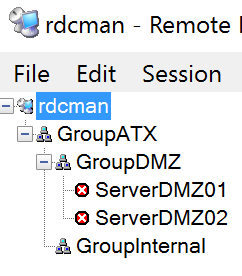

Managing settingsīy default, all new connections inherit the group settings. In practice, of course, you would use a filter other than '*'. Alternatively, you could read the names of hosts from Active Directory since the tool itself is not able to query AD: (Get-ADComputer -Filter \* | select name).name | Out-File -FilePath. The display name and any description must then be added or changed manually because this data cannot be imported. \\servers.csv | select hostname).hostname | You can then use PowerShell to extract the names and write them into a text file using a command like this: (Import-Csv -Delimiter " " -Path.

Importing hosts from a text file into a groupįor example, if you want to migrate your server list from the alternative connection manager mRemoteNG to RDCMan, you first export it as a CSV file.


 0 kommentar(er)
0 kommentar(er)
